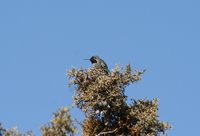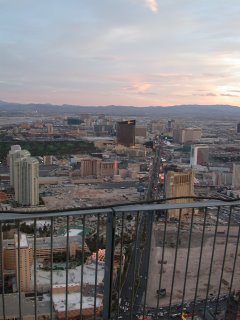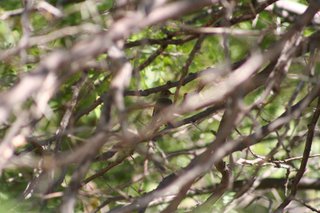A Great Black-backed Gull spent a few days on Rist Benson Reservoir here in Larimer County last January, and on 1/20 I digiscoped several decent shots of it in very good light, with the idea that I might submit a report of the sighting to the Colorado Bird Records Committee (CBRC). Well, a couple days ago I finally did submit a report of that sighting to the CBRC. Whether my report and accompanying photos will be good enough to merit confirmation by the committee remains to be seen, although I suspect they will. In any case it was an important step for me in my continuing evolution as a birder, to make a concerted effort in documenting my observations for the benefit of others.
I've written several times on this topic of personal evolution now, noting how differently I approach this hobby of mine from how I did several years ago. At some point I hope to tire of it, and devote my writing energies solely to the subject matter itself, but during the process of submitting that report I was struck by one particularly sharp contrast between "then" and "now", which is actually kinda funny, but also one that I think is interesting to explore.
Part of the CBRC record report form requires delineation of differences between the bird species you think you saw with those of similar-looking species; i.e., how did you know it was a Great Black-backed Gull and not some other gull. In the case of the GBBG, similar North American occurrences include other rarities like the Slaty-backed Gull and the Yellow-footed Gull, neither of which I've seen before. But I took the time to investigate them, especially in the
Olsen/Larsson book on Northern Hemisphere gulls. It was then that I made an amusing realization about my evolution as a birding enthusiast.
As recently as 4 years ago, I would
never have taken the time to study a species of bird I'd never seen before. That in itself isn't necessarily unusual or damning - beginners or novices don't often take the time for indepth study of unfamiliar birds. But in my case, it wasn't that I didn't have the time, or was confused enough just learning the birds that I had seen. Rather, it was that
I purposefully didn't want to spoil the joy or surprise that comes from beholding a bird when you encounter it for the first time. I even felt that knowing its name beforehand seemed to pollute the sense of wonderment.
Where did this bizarre conception come from? I recall a highly formative experience back in 1998, shortly after I moved from Davis, California (where I went to grad school) to the Bay Area (where I started my first job). My first social bird experiences were with the Sequoia Audubon Society on the Peninsula, and at one of my first meetings there was a presentation from someone who went to Alaska and the North Pacific. He had some terrific pictures of species I'd never seen or heard of before, and I was enthralled. Kittlitz's Murrelet, Red-faced Cormorant, Spectacled Eider...it was exciting to think of all the great bird species out there that I had yet to learn about. World birds were like the candies in Willy Wonka's factory - magical and brilliant, mysterious and alluring.
But I then perceived a risk to my future experiences of seeing new birds - that of knowing too much beforehand. I feared that the magic, brilliance, mystery and allure of these birds would be diminished if I'd read too much or seen too many photos of them in advance. Wasn't part of the thrill of exploration not knowing what lies beyond the next bend in the river, or on the other side of the mountain? In that vein I think I subconsciously resolved to put the blinders on, to not to delve too deeply into bird guide books, and instead to just wait for the birds to reveal themselves to me. I didn't want birding to be a science - I already was a scientist, and birding was an artsier side-interest. I wanted to adhere to this aesthetic, an almost-romantic notion of what it meant to be on a journey of pure discovery - even a forced, false one - in which the discoveries would be not for furthering the knowledge of posterity, but solely for my own feeling of bedazzlement.
And it was easy to accommodate this desire until recently, because for various reasons my birding was still a very solitary activity. I did actually yearn to join bird clubs and go on group outings, but my work schedule made that quite difficult, and besides, birding was more personal therapy than an effort to contribute to the broader birding community knowledge base. But after moving to Colorado, where I had gobs more time and a youthful, active birding community to join, my objectives changed fairly rapidly. I think I did continue to bask in willful bird ignorance for a short time; but the newness of the area and the feeling that I had external expectations on me from locals because of my claims of being an avid birder inspired me to give up this phony notion of "not wanting to ruin the surprise" and actually start to have some real idea of what I was talking about.
At this point I freely admit that I haven't really foregone the joy and wonder in seeing new birds when I study them before actually seeing them. What I've realized over time is that the ideal I was hoping to uphold after that Sequoia Audubon meeting in 1998 has been sublimated to a different form of gratification, one derived from the sharing of knowledge and the
unraveling of mystery, and not in simply pretending that me not knowing something constitutes a state of purity to be cherished. Furthermore, I now recognize that learning what I can about birds beforehand just accelerates me to the next mysteries, like "What is that bird doing here this time of year?" or "How has convergent evolution made this species so similar to this other one on another continent?"
What it comes down to is that I now trust that I won't run out of things to be amazed at. Nature seems to do a good job at presenting conundrums, and learning what you can when you can about it doesn't diminish its marvel or grandeur. And maybe it's silly that I had to come to this understanding in such a roundabout fashion; but looking back, how could I have arrived here any differently?
tags: birding, navel gazing
 One other amusing bird-related experience we had in Vegas was the Fremont Street Experience, a block-long archway of lights over Fremont Street in downtown that act as a movie-screen for passersby on their way to casinos and shops. High-wattage speakers also line the street providing booming audio. One of their shows is called "American Freedom", a 4-minute long rip-roaring, flag-waving bonanza to the music of John Philip Sousa.
One other amusing bird-related experience we had in Vegas was the Fremont Street Experience, a block-long archway of lights over Fremont Street in downtown that act as a movie-screen for passersby on their way to casinos and shops. High-wattage speakers also line the street providing booming audio. One of their shows is called "American Freedom", a 4-minute long rip-roaring, flag-waving bonanza to the music of John Philip Sousa.
















